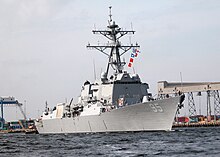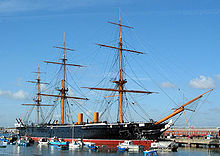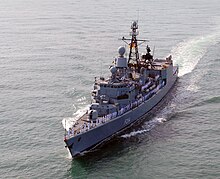Warship
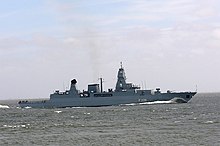

A warship is a ship equipped for war . Seafaring peoples and powers began early on to develop different types of ships for warfare , defense and sea trade . With the beginning of the modern era , sailing ships took the place of rowed warships , only to be replaced by machine-powered ships from the middle of the 19th century.
Towards the end of the 19th century, the development of new types of ships for various forms of naval warfare began, including submarines and aircraft carriers that carry naval warfare into the third dimension. Other special warships are anti-mine vehicles for fighting sea mines and landing craft for amphibious warfare . In addition, special auxiliary ships were developed to support the combat ships.
Term warship
In view of the variety of types and forms of use, the distinction between warships and other ships cannot always be clearly defined. The type designations have evolved over time in terms of size, armament and tasks. Type designations can also be subject to political influences. In addition, the use of certain terms differs from country to country and is fluid between certain types.
Definition in the Convention on the Law of the Sea
In the United Nations Convention on the Law of the Sea (UNCLOS) of 10 December 1982, the term in Article 29 (definition of warships) is defined in a binding manner under international law:
“For the purposes of this Convention, a 'warship' means a ship belonging to the armed forces of a state and bearing the external markings of such a ship of its nationality; it must be under the command of an officer who is in the service of the respective State and whose name is included in the relevant ranking of the armed forces or in an equivalent list; the crew must be subject to the rules of military discipline. "
The “external identification of such a ship of its nationality” is to be understood as the flag of the naval forces of the respective country. The stipulation that the crew must be subject to the "rules of military discipline" means that the crew must consist of soldiers within the meaning of international law .
Article 32 UNCLOS provides that warships enjoy immunity . This means that foreign states are not allowed to exercise any legal power on warships that are in their territorial waters or ports. The same applies to state ships that are not used for commercial purposes, such as civilian-manned military auxiliary ships.
The legal status of a warship does not depend on its armament and technology. The unarmed training ship Gorch Fock of the German Navy , for example, is a warship; The patrol boats of the Federal Border Guard , which in the past were even armed with light artillery, were not warships, however, as their crew consisted not of soldiers but of law enforcement officers.
Auxiliary ships
In addition to warships, many navies have civilly manned auxiliary ships , some of which also carry light weapons for self-defense. They do not have the status defined above, but that of a state ship. In the German navy, for example , there are tankers that are manned by civilians, but are used together with warships. The US Navy and the British Royal Navy also have a large number of such vehicles. Support vehicles manned by the military, such as the Berlin- class suppliers , are sometimes referred to as auxiliary ships, but their status is warships.
Naming of the warships
It has been a long tradition in all navies to give warships a name. Later, prefixes and identifiers made up of letters or numbers were added in many navies. In some navies such as the US Navy, the prefix and identifier are part of the ship's name, in others, such as the German Navy, they are not.
Naming
The naming traditions of the navies have always been an expression of their self-image as part of state power. Dynastic names like "Wasa" or "Hohenzollern" were chosen in monarchies. Today's republican states, on the other hand, often express the bond between the armed forces and the population through the choice of place or area names (“Braunschweig”, “Ohio”). It is also customary to honor personalities (“Charles de Gaulle”, “Bismarck”) and to remember battles (“Trafalgar”, “Yorktown”). Animal names ("Tiger", "Scorpion"), astronomical names ("Aldebaran", "Sirius") and terms from ancient times ("Hermes", "Leander") are also used. Some navies also name their ships according to their characteristics ("Invincible", "Le Triomphant").
Some vehicles only have a combination of letters and numbers instead of a name. Traditionally, this applies to all German submarines (“U 31”) with the exception of some test and school boats ( “U-Hai” ).
In Northern Europe and North America, ship names are mostly female, especially when it comes to ships that are named after people or geographical terms (the "Eisenhower", the "Hamburg"). Ships named after an expression with an article (for example animals, astronomical terms) normally retain the gender (the "ram", the "ferret"), but the feminine form can also be used (the " Arrow"). In Romance and Slavic languages, the gender of the name is retained. The Austrian seaman's language (until 1918) is based on it - there was the “Szent Istvan”, the “Empress Elisabeth”, the “Sankt Georg” and the “Vienna” (from: the city) .
Prefixes
In some navies, the ship names are prefixed, such as USS or HMS. These prefixes can be part of the ship's name. The German Navy has not used a prefix since 1918, after the ships were previously referred to as SMS (His Majesty's Ship).
Based on these national prefixes, it is customary in international alliances such as NATO to put a prefix based on an English abbreviation in front of all ship names in order to be able to address ships precisely in correspondence. The abbreviation FGS for " Federal German Ship " is used for German warships . These NATO prefixes are not part of the name and do not have to match the national prefixes.
Identifiers
In order to be able to visually distinguish ships of the same type even at greater distances, identifiers consisting of numbers or letters were introduced, with the different navies using or having used very different systems. These identifiers are essential in optical signal traffic, i.e. in communication with headlight or flag signals, in order to clearly address the various ships in a formation and thus prevent errors.
In the German Navy up to about 1957, identifiers consisting of two letters were common, which were based on the ship's name (SX for ship of the line " Schleswig-Holstein ", ST for coastal minesweeper "Seestern"). Subsequently, the system of letters and numbers customary in NATO was introduced.
The NATO system is similar to the US system, in which ships are identified with a letter combination for the type (type indicator) followed by an order number (DDG-2 Charles F. Adams), with US ships only showing the number (DDG -2: "2"). However, only one letter is used for the NATO identification, the so-called Hullnumber (hull number) (F 207 for frigate “Bremen”). This NATO system is also used in many western-oriented navies. Other navies have different systems that often only consist of numbers. Sometimes these numbers express the membership of ships in an association (for example 52 as 2nd ship of 5th squadron).
During war and missions, the identifiers are partially removed, reduced in size or applied with low-contrast paint.
Ships with a flight deck usually have a two-letter identifier based on the name of the ship on the flight deck in addition to the Hull number, in order to be easier to identify from the helicopter.
history
Antiquity
The first typical warships were built by the Greeks , Persians and Phoenicians . They were longships that were later developed into galleys with ram rams .
Around 250 BC The Carthaginians owned the largest and most powerful fleet of warships in the Mediterranean with up to five rowers in three levels of oars one above the other ( quinqueremen ). This changed in the First Punic War when the Romans rebuilt a stranded Carthaginian rowing ship.
The Romans added the Corvus , a boarding bridge, to the Carthaginian construction and manned the ships with foot soldiers. This is how the first marine infantry came into being .
Vikings
In Northern Europe the type of Viking longship was developed, which was particularly fast and suitable for raids. It enabled the establishment of the Viking empires in Russia , Normandy , Sicily and Great Britain .
China
In the Empire of China larger junks were built as warships. The climax of this development was in the Ming Dynasty around 1405 to 1430, when China had the largest war fleet in the world at that time with more than 300 ships, most of which were built in Nanjing . The decisive factor was the Chinese admiral Ma San Bao, also known as Zheng He , who traveled to Southeast Asia , India and Africa to fight pirates and to ensure China's supremacy . The largest type of ship were the so-called treasure ships , which had up to 9 masts and were around 70 meters long.
Hanse
For Hanseatic period , the navies in northern Europe consisted mainly of more armed Hanseatic cogs and Kraweelen that hardly differed in construction of merchant ships.
15th and 16th centuries
That changed in the 15th and 16th centuries , when firearms increasingly dominated warfare . In the Mediterranean, which arose from the galleys schooner . The Portuguese and Spaniards further developed the ship type of the cog and the kraweel into caravels and carracks . The Spanish Armada became the largest fleet in the world at the time. The galleon was developed as a pure sailing ship , which was used both as a trading ship and (in a leaner form) as a warship. An example of this is Sir Francis Drake's Golden Hinde .
The sailing ships now dominated warship construction, the ships of the line with a slimmer hull than the merchant ships dominated the seas from the 17th century . The model for the first ships of the line was the Henri Grâce à Dieu , which in 1547 had 21 cannons with a displacement of 1000 tons. The ship's guns , which were initially set up on the upper deck and shot bullets made of stone or iron, were housed in special weapon decks ( battery deck ) behind gun ports .
As a result, the center of gravity was shifted downwards and more cannons could be transported without increasing the risk of capsizing. The preferred fighting technique now became the broadside , in which one side was shot from all tubes. The engine of this development was John Hawkins . His goal was fast ships with good sailing characteristics and strong armament. With these ships, the change of tactics (and a powerful storm), the English fleet defeated and destroyed the Spanish Armada in 1588.
17th century
The Prince Royal , built in 1610, was the first ship with three tiers of guns and for a long time the largest warship in the world. The Naseby , renamed the Royal Charles in 1660 , became the prototype of the warship for the next 150 years. She had 1230 tons of water displacement, 80 cannons and a crew of 600 men with a length of 53 m and a width of 14 m. In addition to the larger ships of the line, the frigate soon appeared as a smaller but particularly fast sailing warship with around 20–40 cannons.
18th century
During the 18th century, the hulls became narrower and more elegant. Famous ships from this period are:
- Victory , the flagship of Lord Nelson in the Battle of Trafalgar . She was laid down on July 23, 1759, but did not enter service until 1776. From 1778 she served as the flagship of various admirals and is now the oldest warship still in service. The length is 69 m, the greatest width 15.7 m, the water displacement 3556 tons. She carries 114 guns and reached a top speed of 11 knots.
- Constellation , the first ship to be built for the US Navy in 1797. It combined the firepower of a Razee of that time with the speed of a Baltimore clipper. The water displacement is 1278 tons, the length 55 m, the width 13 m. She was armed with 36 cannons. The speed was 14 knots, so she got the nickname "Yankee Racehorse" (Yankee race horse).
19th century
With the industrial revolution in the 19th century there was a surge in development that spawned a whole series of inventions: the steam engine , the paddle wheel drive, the propeller, the introduction of grenades and armor. The grenades were not yet fully developed at the time of the Napoleonic Wars , but after their problems had been eliminated (from around 1830) they had a devastating effect on unarmored wooden ships.
Therefore, the wooden ships were initially armored with steel plates . Steam warships were initially built as paddle steamers, and increasingly as screw steamers in the second half of the 19th century. The steam propulsion allowed for better maneuverability.
After the Crimean War , two revolutionary ships were built, the first " Ironclad Warships ", which suddenly rendered all other ships worthless:
- the French La Gloire 1858 and the one superior to it
- British Warrior 1859. At 15 knots speed she was faster, more heavily armored with 114 mm steel on teak and more heavily armed with 40 heaviest guns than any other ship. Their own guns could no longer penetrate the armor at 360 meters.
Due to this superiority of armor, the tactic of ramming became common for a short time ( Naval Battle of Lissa 1866).
Rotatable gun turrets were first used on small coastal warships ( monitor ), and from around 1870 also on large warships. At that time, the masts and sails that were still needed for the worldwide use of warships disappeared, so that by the end of the 19th century there were practically only steamships left. However, many names for ship classes have been adopted from sailing shipbuilding, such as the frigate and corvette . The armored cruiser was born as a new type .
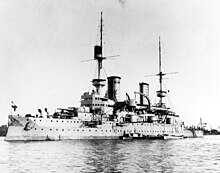
The towed breech- loaders came into use relatively late at sea, as the advantages (better aiming accuracy) at the short combat distances at sea were outweighed by the disadvantages (lower caliber , unreliable locks, gunfire ). Between 1880 and 1890, however, large calibers with long barrels and armor-piercing bullets were able to overcome the armor.
Beginning of the 20th century
After the naval battle at Tsushima in 1905, the experience gained was implemented consistently: effective fire control could only be achieved by standardizing the calibers, and a long range of shots only with large-caliber artillery.
The Dreadnought was created within a year and was equipped with ten 30.5 cm guns , could deploy at least six of them in any direction and fire twice a minute. Like the Warrior , this ship was the beginning of a new era in warship construction. All previously built ships of the line, which were still equipped with a mixed battery of different calibers, were thereby greatly reduced in their combat value.
In the Skagerrak Battle , the battle was fought over 10,000 meters away, which was unthinkable with earlier types of ships and guns. The Skagerrak Battle remained the largest naval battle in contemporary history to be fought with battleships .
After the First World War, the Treaty of Versailles allowed the German Navy only a limited replacement of the few remaining battleships (these were carried under the old term ship of the line). The tactical development in Germany in the 1920s and 1930s therefore moved away from the heavy battle fleet towards cruisers. The consequence of the narrow contractual limits was the development of the armored ships , referred to by the foreign press as "pocket battleships" , the first prototype of which was the armored ship Germany . Here the characteristics of high speed, heavy armament and long range were combined. The first use of diesel engines and a (in direct comparison) massive weight reduction served for this purpose. The strategic concept behind it was referred to as the “Overseas Cruiser War”. The idea found expression in the sentence: "Faster than heavily armed and more heavily armed than faster!"
Both the Deutschland (later reclassified as the heavy cruiser Lützow ) and her sister ships Admiral Scheer and Admiral Graf Spee initially fought this cruiser war very successfully in World War II, as did the Scharnhorst and Gneisenau, originally planned as enlarged ironclads and later completed as battleships .
The development of submarines has also made decisive progress since the beginning of the century, and submarine technology was particularly advanced in Germany . These were only technically possible thanks to the electric drive and the development of powerful accumulators . The torpedo was and is a typical weapon in submarines . Thus, since the First World War , these boats were able to attack and sink other ships largely undetected.
In addition, the torpedo boats emerged , small, fast and, above all, inexpensive boats whose main weapon was also the torpedo and which were used against the battleship fleets. Their guns were too slow to repel torpedo boats effectively. To defend against the torpedo boats, the torpedo boat destroyer, later called destroyer for short , was created.
Up to the First World War, balloon ships were also used, which were equipped with a manned balloon to observe the surrounding sea . However, they were still displaced by aircraft mother ships in World War I.
Second World War and subsequent period
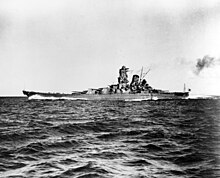
This practically ended the development of the battleship , because the battleships of the Second World War, such as the battleship Bismarck , had, due to their size, in addition to the unchanged main armament, a medium artillery of smaller guns and anti-aircraft cannons .
During the Second World War , the military effectiveness of the submarines was increasingly neutralized by surveillance with aircraft and radar as well as the defensive measures of destroyers . After the war, new types came into use, which in turn increased the combat value of the boats. By nuclear reactors large submarines were from the mid- 20th century, the ability for a long time to operate without access to bases at sea. Such nuclear submarines often serve as mobile launching bases for strategic nuclear missiles.
Another development is the aircraft carrier , the development of which began in the First World War and was accelerated in the Second World War. The British attack on Taranto in 1940 and the Japanese attack on Pearl Harbor in 1941 demonstrated its superiority over conventional warships and resulted in aircraft carriers becoming an integral part of the great navy.
present
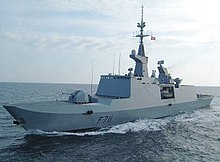
Today, primarily destroyers , frigates and corvettes are in use, which are often equipped with guided weapons and thus - similar to submarines - can serve as mobile launching bases. But there are also guided missile warships classified as cruisers , such as the units of the Russian Kirov class or those of the US Ticonderoga class .
Lightly armed minesweepers are used for coastal protection . Speedboats make it possible to intercept unauthorized ships at an early stage. Amphibious warships have also played a major role since World War II . This includes large landing ships, most of which are equipped with helicopters and some with a dock area. Small, very shallow landing craft can bring crews, vehicles and material to shore. These boats are usually only lightly armed.
Modern aircraft carriers enable the use of bombers and fighters far away from land-based bases and played an important role in the Second and Third Gulf Wars . They also serve as a command platform for large ship formations. Because of their size, aircraft carriers are vulnerable to attack with anti-ship missiles and torpedoes.
Signature reduction plays an important role in warship construction. The best known is stealth technology , which makes it difficult to locate using radar devices . The US Navy used the stealth ship Sea Shadow as a prototype . At the same time, however, it is also a matter of counteracting location by other sensors . This is why the infrared, magnetic and sound signatures have been reduced for a long time.
Technology in Modern History
Armament
The defining element of a warship is its armament. This depends on the type of operations and the goals to be combated .
In earlier times up to the Second World War, warships regularly only had naval artillery in various calibers that were used against other sea targets (see also: medium artillery for medium-sized calibers, turrets for technical integration on board). With the development of military aviation , further guns in the form of anti-aircraft cannons (flak) of smaller caliber were added to be able to repel enemy aircraft (air targets). With technical progress, guided missiles gained more and more importance, both for defending against enemy ships and enemy aircraft. Today anti- ship missiles are used against ships in addition to modern ship artillery , and anti-aircraft missiles (FlaRak) against airplanes and helicopters . These are started from deck launch devices or built-in vertical take-off systems .
Sea mines can be laid from warships using mine throwing equipment.
Submarines are regularly armed with torpedoes that are fired from torpedo tubes . Torpedoes come in different calibers and weight classes and are used against other submarines as well as surface ships. In earlier times, submarines often had mine laying devices and deck guns. Modern submarines are able to lay sea mines or launch anti-aircraft missiles from the torpedo tubes. Submarines with ballistic missiles have first-strike and second-strike weapons using submarine-based ballistic missiles with nuclear warheads.
In the past, grenades and depth charges were mainly used in the area of submarine hunting against enemy submarines . Special grenade and depth charge launchers were equipped for this purpose . Today surface units for submarine hunting regularly have several torpedo tubes for firing torpedoes. With the advent of faster submarines, anti-submarine missiles (ASROC) were also developed, which first bring a torpedo closer to the submarine using a rocket engine and only then cover the rest of the distance in the water. Some anti-submarine missiles can also be launched submerged from submarines.
On- board helicopters , which are armed with torpedoes or anti-ship missiles, can be used both for combating surface-sea targets and for submarine hunting .
Missiles are also used to combat land targets. These are often specially adapted anti-ship missiles or cruise missiles . In addition to surface ships, cruise missiles can also be fired from submarines . Land target shelling by artillery weapons is also possible, but because of the comparatively low range, this is less important than missiles. However, this development is counteracted on younger warship classes: modern ship guns of larger caliber with special range-extended ammunition are increasingly being used again for tactical fire support on land.
Close-range defense systems (CIWS) are used to defend modern warships against approaching missiles or small surface vehicles. A close-range defense system usually consists of a fully automatic, radar-controlled rapid-fire cannon with rotating barrels or an anti-aircraft missile system. It forms the last line of defense of a warship. Machine guns and small-caliber machine cannons are also used against small targets and asymmetrical threats.
Decoy systems are also used for self-protection .
Construction and armor


Warships are designed and equipped for the highest possible survivability of the unit. For this purpose, strong armor ( ironclad , armored decks ) was used in earlier times . With the development of new, powerful weapon systems, however, this strategy became obsolete and has noticeably disappeared since the end of the Second World War.
Today, special, high-strength and corrosion-resistant steel alloys are used for shipbuilding (see e.g. submarine steel ) and a structurally safe construction and technology with high stability ( sectional construction , bulkheads , double hull ) are sought. Furthermore, modern warships are often constructed according to the two-island principle , ie all systems that are important for operation are distributed over the two island structures or are redundant . Only particularly endangered areas and parts of the ship (e.g. hangars, magazines and fuel stores) are armored separately, e.g. with Kevlar mats .
The Gerald R. Ford -class aircraft carriers will receive a new passive protection system. It is called "dynamic armor" and is intended to protect critical parts from shaped charge warheads. It is based on two plates, which are charged differently and a few centimeters apart. A sufficiently large amount of electrical energy is stored via capacitors . If the metal spike (usually copper ) from the shaped charge warhead creates an electrical connection, the current flowing between the two plates causes the jet to evaporate immediately, which minimizes the effect of such weapons.
Modern warships are also often built in stealth construction ( stealth ship ), which gives them a smooth, flat appearance. The inclined arrangement of all (above water) areas reduces the radar cross-section . The result is a smaller radar signature: the ship is more difficult and later to be recognized by the opposing radar. In addition, special radar absorbing materials and coatings are used. Further camouflage measures concern the heat (infrared) and sound insulation (sonar) of ships and submarines.
Traditions and Uses
Many navies around the world paint the bow tip of their ships, also known as the "nose" , when they have passed a certain area on a voyage. The usual colors are “red” for crossing the equator , “blue” for crossing the Arctic Circle , “yellow” for traveling through the Suez Canal and “black” for staying in the Black Sea . If several areas have been traveled, the nose can also be designed in two colors. After an uncommitted period, e.g. B. one year or before the start of a new journey, the nose is painted gray again.
Web links
literature
- Bernd Loose / Bernd Oesterle: The great book of warships (19th & 20th century), Motorbuch Verlag, ISBN 3-613-01854-3
Individual evidence
- ↑ Marine Glossary of the German Maritime Institute ( Memento of 13 June 2016 Internet Archive ), accessed on February 3, 2016th
- ^ Duden, Die Grammatik, 7th, completely new and expanded edition, Volume 4, Mannheim, Leipzig, Vienna, Zurich 2005; P. 163, rule 247.
- ↑ Section II. Provisions on Sea Power . (Articles 181 to 197, online ).
- ^ Defense Technology International, December 2008, p. 38.
- ↑ A red nose for the "Hessen" , Bundeswehr in action, Bundeswehr, March 24, 2014. Accessed on September 4, 2015.





